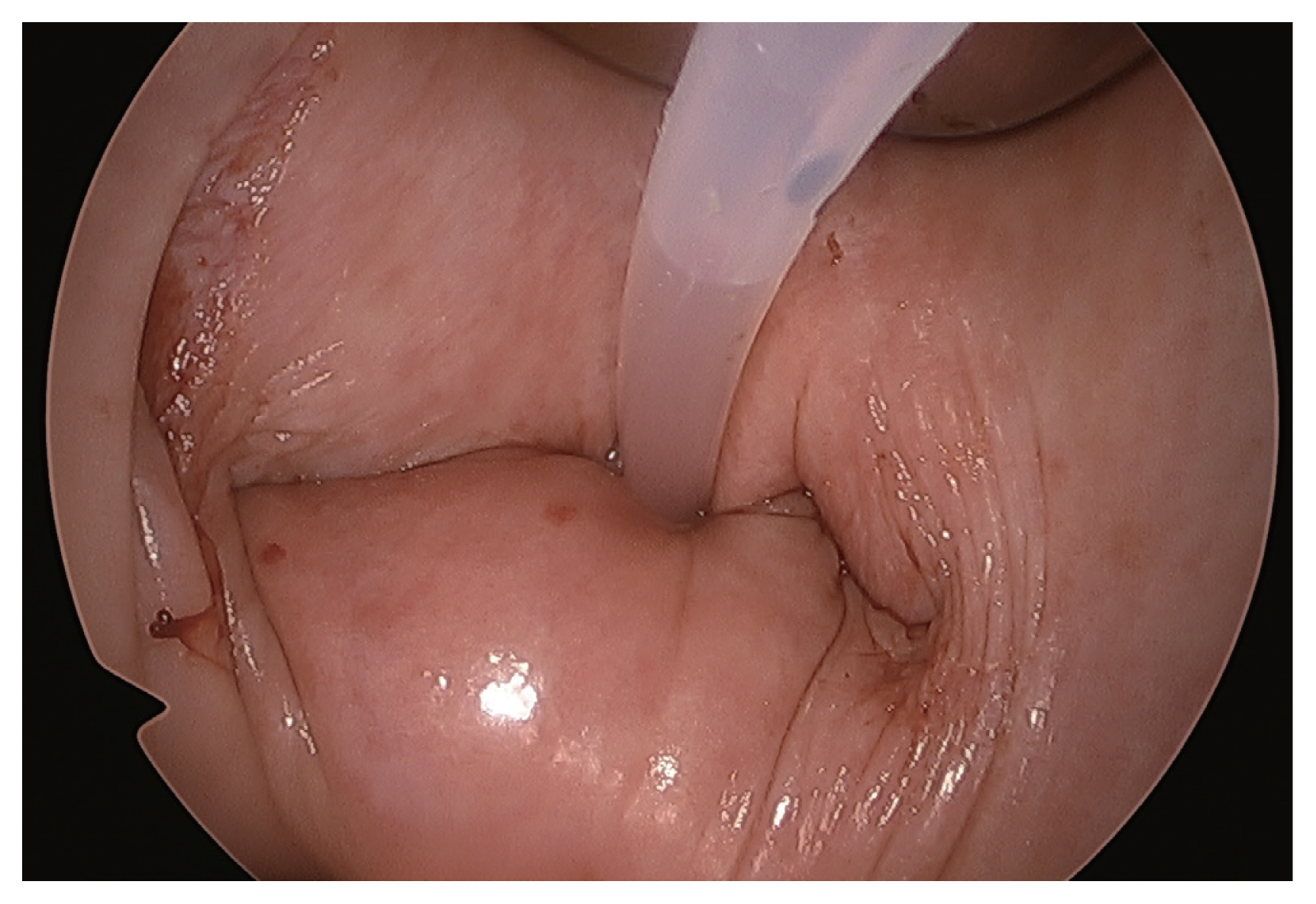Obstet Gynecol Sci.
2022 Sep;65(5):477-482. 10.5468/ogs.22083.
Vaginal vault drainage as an effective and feasible alternative in laparoscopic hysterectomy
- Affiliations
-
- 1Department of Obstetrics and Gynecology, Gil Medical Center, College of Medicine, Gachon University, Incheon, Korea
- KMID: 2533821
- DOI: http://doi.org/10.5468/ogs.22083
Abstract
Objective
Infected pelvic hematoma is a serious complication of hysterectomies. Pelvic drainage can help reduce complications. In this study, we evaluated the efficacy and safety of vaginal vault drainage in patients who underwent laparoscopic hysterectomy for benign gynecological diseases.
Methods
Patients who underwent laparoscopic hysterectomy and pelvic drain insertion for benign gynecological diseases between January 2008 and December 2015 were enrolled retrospectively in the study. They were grouped according to drain insertion sites, that is, through the abdomen (group 1) and vaginal vault (group 2). The postoperative outcomes were compared between the two groups.
Results
A total of 504 women were included. No significant differences were observed in the prevalence of postoperative fever, readmission, and reoperation between the two groups.
Conclusion
Given the discomfort associated with holding and removing the abdominal drain, inserting a closed pelvic gravity drain through the vaginal vault appears to be a feasible alternative to an abdominal drain.
Keyword
Figure
Reference
-
References
1. Kovac SR. Hysterectomy outcomes in patients with similar indications. Obstet Gynecol. 2000; 95:787–93.
Article2. Johnson N, Barlow D, Lethaby A, Tavender E, Curr E, Garry R. Surgical approach to hysterectomy for benign gynaecological disease. Cochrane Database Syst Rev. 2006; (2):CD003677.
Article3. Kuhn RJ, de Crespigny LC. Vault haematoma after vaginal hysterectomy: an invariable sequel? Aust N Z J Obstet Gynaecol. 1985; 25:59–62.
Article4. Rosen DM, Cario GM. Vault haematoma following laparoscopic hysterectomy. Aust N Z J Obstet Gynaecol. 1997; 37:220–2.
Article5. Swartz WH, Tanaree P. Suction drainage as an alternative to prophylactic antibiotics for hysterectomy. Obstet Gynecol. 1975; 45:305–10.6. Thomson AJ, Sproston AR, Farquharson RG. Ultrasound detection of vault haematoma following vaginal hysterectomy. Br J Obstet Gynaecol. 1998; 105:211–5.
Article7. Wood C, Maher P, Hill D. Bleeding associated with vaginal hysterectomy. Aust N Z J Obstet Gynaecol. 1997; 37:457–61.
Article8. Slavotinek J, Berman L, Burch D, Keefe B. The incidence and significance of acute post-hysterectomy pelvic collections. Clin Radiol. 1995; 50:322–6.
Article9. Dua A, Galimberti A, Subramaniam M, Popli G, Radley S. The effects of vault drainage on postoperative morbidity after vaginal hysterectomy for benign gynaecological disease: a randomised controlled trial. BJOG. 2012; 119:348–53.
Article10. Lee SJ, Roh HJ, Cho HJ, Lee SH, Ahn JW, Kwon YS. Vaginal vault drainage after complicated single-port access laparoscopic-assisted vaginal hysterectomy. Gynecol Minim Invasive Ther. 2017; 6:58–62.
Article11. Feferkorn I, Schmidt M, Segev Y, Zilberlicht A, Auslender R, Abramov Y. Vaginal cuff closure technique and the risk for infected pelvic hematoma after vaginal hysterectomy. Eur J Obstet Gynecol Reprod Biol. 2016; 206:194–7.
Article12. English EM, Bell S, Kamdar NS, Swenson CW, Wiese H, Morgan DM. Importance of estimated blood loss in resource utilization and complications of hysterectomy for benign indications. Obstet Gynecol. 2019; 133:650–7.
Article13. Takeyama S, Aoki Y, Kamimura N, Suzuki M, Tanaka K. Retrieval of intraperitoneal Penrose drain under transvaginal endoscopic guidance. Gynecol Oncol. 2006; 102:391–3.
Article14. Meretyk S, Clayman RV, Myers JA. Retroperitoneoscopy: foreign body retrieval. J Urol. 1992; 147:1608–11.
Article15. Hartanto VH, Han K, Ankem M, Diamond SM. Endoscopic retrieval of retained Jackson-Pratt drain. Urology. 2001; 57:973–4.
Article16. Beshai AZ, Flashner SC, Walther PJ. Endoscopic release of retained Penrose drains: a simple solution for an old problem. J Urol. 1992; 147:1067–8.
Article17. Leonovicz PF, Uehling DT. Removal of retained Penrose drain under fluoroscopic guidance. Urology. 1999; 53:1221.
Article
- Full Text Links
- Actions
-
Cited
- CITED
-
- Close
- Share
- Similar articles
-
- Three cases of vaginal evisceration after laparoscopic hysterectomy
- Vaginal vault evisceration after total laparoscopic hysterectomy
- Prolapse of Fallopian Tube into Vaginal Vault after Hysterectomy: A case report
- Four Cases of Repair of Post Hysterectomy Vaginal Vault Prolapse
- Five cases of abdominal sacral colpopexy for the vaginal vault prolapse after total hysterectomy



